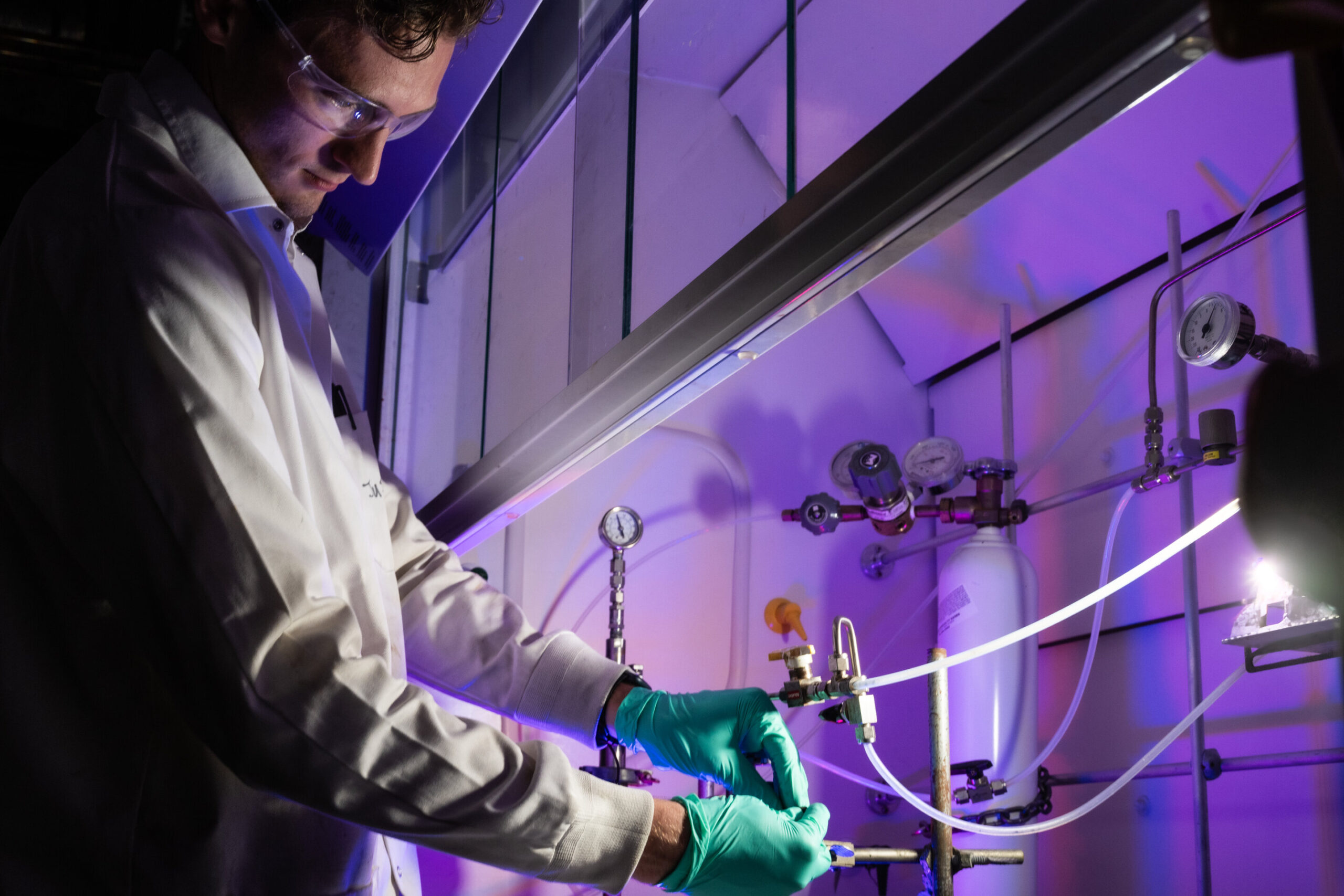Tech
Flash Joule heating lights up lithium extraction from ores

A new one‑step, water‑, acid‑, and alkali‑free method for extracting high‑purity lithium from spodumene ore has the potential to transform critical metal processing and enhance renewable energy supply chains. The study is published in Science Advances.
As the demand for lithium continues to rise, particularly for use in electric cars, smartphones and power storage, current extraction methods are struggling to keep pace. Extracting lithium from salty water is a lengthy process, and traditional methods that use heat and chemicals to extract lithium from rock produce significant amounts of harmful waste.
Researchers led by James Tour, the T.T. and W.F. Chao Professor of Chemistry and professor of materials science and nanoengineering at Rice University, have developed a faster and cleaner method using flash Joule heating (FJH). This technique rapidly heats materials to thousands of degrees within milliseconds and works in conjunction with chlorine gas, exposing the rock to intense heat and chlorine gas, they can quickly convert spodumene ore into usable lithium.
“This method reimagines how to harvest lithium from its most abundant ore, spodumene, a material that is abundant in the U.S.,” said Tour, co‑corresponding author of the study. “We can leapfrog monthslong water evaporation pools and dayslong acid leaching and then directly generate lithium chloride.”
Hypothesis, experiments and the novelty of approach
Guided by thermodynamic calculations, the researchers exposed α‑spodumene, a naturally occurring hard‑rock lithium mineral, to FJH and chlorine gas. This one‑step process eliminates the need for the traditional multistep acid roasting method, allowing lithium to be extracted directly as lithium chloride.
With a flash of electrical current, the mineral shifted from its stable α‑phase to the high temperature‑accessed β‑phase, making lithium available for reaction with chlorine gas. The lithium then vaporized as lithium chloride, while aluminum and silicon compounds were left behind. All of this was complete within seconds.
“Present techniques rely on multistep, chemically intensive treatments,” said study co‑corresponding author Yufeng Zhao, an associate professor of physics at Corban University and visiting professor at Rice. “The unique aspect of this method is the combination of rapid, uniform heating and favorable thermodynamics, which together enable practical and selective extraction.”

Traditional methods, from acid roasting to brine evaporation, simply weren’t designed for ultrafast separation, said Shichen Xu, the first author of the study and a postdoctoral researcher at Rice.
“Our controlled, rapid‑heating approach overcomes kinetic barriers that have hindered single‑step extraction for decades,” Xu said.
Findings and broader significance
The researchers achieved nearly instantaneous lithium extraction from spodumene, producing lithium chloride with 97% purity and 94% recovery, significantly outperforming traditional methods that can take days to months.
“This method paves the way for local, small‑footprint lithium processing units or large‑scale units for massive waste mining operations,” said Justin Sharp, co‑first author and research assistant. “It’s a real paradigm shift. We can now envision battery‑grade lithium production without acids, without large waste outputs and without waiting weeks.”
Additionally, a startup from Tour’s lab, Flash Metals U.S., is already scaling this technology for metals extraction from waste.
“They would be able to rapidly implement this method into their production line once their pilot plant begins operation early next year,” Sharp said.
Environmentally, the elimination of acid and alkali significantly reduces waste burden. Economically, shorter processing times and simpler infrastructure could lower costs and decentralize lithium supply. Academically, the work demonstrates the rapid, acid‑free extraction of lithium from natural ore, raising possibilities for applying FJH and chlorine gas to other strategic minerals.
Co‑authors of the study include Rice’s Alex Lathem, Qiming Liu, Lucas Eddy, Weiqiang Chen, Karla Silva, Shihui Chen, Bowen Li, Tengda Si, Jaeho Shin, Chi Hun Choi, Yimo Han, Kai Gong and Boris Yakobson, along with Yufeng Zhao from Corban University.
More information:
Shichen Xu et al, One-step separation of lithium from natural ores in seconds, Science Advances (2025). DOI: 10.1126/sciadv.ady6457
Citation:
Flash Joule heating lights up lithium extraction from ores (2025, October 7)
retrieved 7 October 2025
from https://techxplore.com/news/2025-10-joule-lithium-ores.html
This document is subject to copyright. Apart from any fair dealing for the purpose of private study or research, no
part may be reproduced without the written permission. The content is provided for information purposes only.
Tech
OpenAI Locks Down San Francisco Offices Following Alleged Threat From Activist

OpenAI employees in San Francisco were told to stay inside the office on Friday afternoon after the company purportedly received a threat from an individual who was previously associated with the Stop AI activist group.
“Our information indicates that [name] from StopAI has expressed interest in causing physical harm to OpenAI employees,” a member of the internal communications team wrote on Slack. “He has previously been on site at our San Francisco facilities.”
Just before 11 am, San Francisco police received a 911 call about a man allegedly making threats and intending to harm others at 550 Terry Francois Boulevard, which is near OpenAI’s offices in the Mission Bay neighborhood, according to data tracked by the crime app Citizen. A police scanner recording archived on the app describes the suspect by name and alleges he may have purchased weapons with the intention of targeting additional OpenAI locations.
Hours before the incident on Friday, the individual who police flagged as allegedly making the threat said he was no longer part of Stop AI in a post on social media.
WIRED reached out to the man in question but did not immediately receive a response. San Francisco police also did not immediately respond to a request for comment. OpenAI did not provide a statement prior to publication.
On Slack, the internal communications team provided three images of the man suspected of making the threat. Later, a high-ranking member of the global security team said “At this time, there is no indication of active threat activity, the situation remains ongoing and we’re taking measured precautions as the assessment continues.” Employees were told to remove their badges when exiting the building and to avoid wearing clothing items with the OpenAI logo.
Over the past couple of years, protestors affiliated with groups calling themselves Stop AI, No AGI, and Pause AI have held demonstrations outside the San Francisco offices of several AI companies, including OpenAI and Anthropic, over concerns that the unfettered development of advanced AI could harm humanity. In February, protestors were arrested for locking the front doors to OpenAI’s Mission Bay office. Earlier this month, StopAI claimed its public defender was the man who jumped onstage to subpoena OpenAI CEO Sam Altman during an onstage interview in San Francisco.
In a Pause AI press release from last year, the individual who police said was alleged to have made the threat against OpenAI staffers is described as an organizer and quoted as saying that he would find “life not worth living” if AI technologies were to replace humans in making scientific discoveries and taking over jobs. “Pause AI may be viewed as radical amongst AI people and techies,” he said. “But it is not radical amongst the general public, and neither is stopping AGI development altogether.”
Tech
Activists Are Using ‘Fortnite’ to Fight Back Against ICE

SteveTheGamer55 is live on YouTube. He’s streaming a session to his 4.6 million subscribers of GTA 5 RP, a Grand Theft Auto 5 mod that allows people to role-play with other players. “Really wanna show you guys some real-life scenarios,” he says, offering a little background on his character, a man headed to his job while on a work visa.
His character doesn’t get far before an SUV swings onto the sidewalk in front of him; masked ICE agents spill out of the vehicle. “Stop right there,” one of the uniformed players says. It isn’t long before SteveTheGamer55 is surrounded by agents. He hands over his ID while bystander players yell at the agents and demand his release. “Why are you harassing people?” one says, before the worker is finally let go. Later in SteveTheGamer55’s play session, he stands in front of a large iron gate reminiscent of those in ICE detention centers seen in cities like Chicago. More in-game ICE agents have gathered. He records from his phone. Just in front of him, a player in a red suit demands to see a warrant for his client.
The “special event” held on November 20, where players took on different roles that reflect real-life ICE raids, was the first initiative by New Save Collective, a baker’s dozen of gamers with backgrounds in activism and organizing, whose goal is to educate gamers and teach people about their rights when dealing with ICE in real-world situations. On November 21, at 7:30 pm ET, gamers will gather in Epic’s massively popular battle royale, Fortnite, to hold a closed scavenger hunt that will serve as a more casual educational opportunity. The group is working with several immigration advocacy groups, as well as collaborating with content creators, to spread their message online.
Online gaming spaces have long appealed to the right as a place to push conservative or even extremist ideologies. The US military has been open about its attempts to use games as a recruitment tool, and immigration authorities are no different. In October, the Department of Homeland Security posted an image aping marketing for the Halo series. “Finishing this fight,” the agency’s official account tweeted—a reference to Halo 3’s tagline—alongside an image with the text “Destroy the Flood” slapped over a blurry depiction of the game’s supersoldiers; the Flood are Halo’s alien antagonists. DHS has also riffed off of Pokémon’s “gotta catch ’em all” tagline, going as far as to post a video of ICE agents destroying property and arresting people, interspersed with the show’s opening.
A spokesperson previously told The Hill that the DHS “will reach people where they are with content they can relate to and understand, whether that be Halo, Pokémon, The Lord of The Rings, or any other medium.” But where movements like Gamergate peddled in harassment, hatred, and exclusion, New Save Collective’s goal is to foster a community that is kind, authentic, and oriented towards doing good.
“Most of us are immigrants, or children of immigrants, or children of refugees,” says one organizer who goes by PitaBreadFace online. (The organizer requested WIRED not use his name out of safety concerns.) “We’re here at this stage in the political climate to cultivate some belonging, but also move people towards a shared purpose that everyone seems pretty hungry for.”
Tech
MediaWorld Accidentally Sold iPads for 15 Euros. Then It Asked for Them Back

On November 8, an offer for loyalty card holders appeared on the website of MediaWorld, a European electronics retailer. The deal: an iPad Air for 15 euros (about $17) instead of the usual €879 (about $1,012). No catch, no strings attached. The proximity to Black Friday only made the offer more plausible. And so several consumers immediately purchased the product by choosing the “payment and pickup in store” opetion, on paper the safest to avoid unexpected problems.
The process was seamless, even for those ordering online. According to the accounts of some users on Reddit, their order was accepted, and after about 40 minutes they received an email confirming the availability of the product.
In the store, the €15 payment went through successfully and MediaWorld delivered the iPads as expected. The terms and conditions attached to the order make no mention of any clause regarding pricing errors or the possibility for the company to request subsequent additions.
MediaWorld’s About-Face
Eleven days later, however, MediaWorld sent a simple email—not a formal communication via certified mail—stating that the published price was “clearly incorrect.” The company then asked the affected customers to choose between two solutions: Keep the iPad and the difference to match the price but with a €150 discount, or return it and receive a refund of the €15 and a €20 discount voucher for their inconvenience.
MediaWorld’s Response
Following the incident, Wired contacted MediaWorld for comment. “We confirm that, in a very short period of time, due to a clearly recognizable technical error caused by an extraordinary and unexpected glitch on our e-commerce platform, some products were mistakenly displayed at prices that, due to their clear and objective disconnect from the true market value and the correct promotional price, should never have been displayed. This was a manifest error, making it economically unsustainable and not representative of our commercial offering,” a MediaWorld spokesperson explains.
Regarding the subsequent intervention to try to recover the products sold, the representative added: “By virtue of the provisions of the current regulations, we found it necessary to intervene, resorting to a legal principle aimed at preserving the contractual balance in the event of an error of this magnitude. Our approach was to prioritize the relationship with the customer and to offer solutions that went beyond the mere application of law. For this reason, we promptly contacted all affected buyers, proposing two alternatives.”
The MediaWorld spokesperson also confirmed to WIRED the two solutions first highlighted by Reddit users: “We offer product retention: the customer has the option to keep the purchased item, paying the difference between the price paid and the correct promotional price. We have also offered a further discount on the amount to be paid. Or return the product: the customer can choose to return the item free of charge, receiving a full refund of the amount already paid. In this case too, we have offered a MediaWorld shopping voucher. We firmly believe that these proposals demonstrate our willingness to support customers and maintain transparency and fairness. We continue to work to improve our shopping experience and maximum protection for our consumers.”
The Legal Issue: Is the Error Really Recognizable?
On the web, many lawyers point out that Article 1428 of the Italian Civil Code allows a contract to be voided if the error is fundamental and recognizable. But the issue, according to consumer lawyer Massimiliano Dona, is more nuanced than it seems.
“The premise is that the November 19 letter—in which MediaWorld demanded the return or purchase of the iPad at near-real price—is not a formal warning or formal notice, especially if sent by ordinary mail, as it is a proposal for a binary agreement. If the consumer ignores it, MediaWorld will evaluate whether to take formal action,” Dona claims.
“That’s why the key issue is whether, from a legal standpoint, MediaWorld’s claim is well-founded or not. To void a contract, it is necessary to demonstrate the consumer’s awareness of abusing the seller’s error. But to have this proof, it is not enough to claim that the 98 percent discount makes the error obvious in the eyes of the customer.” Furthermore, Dona also points to the fact that, “Today prices are not as standard as they once were. Between limited-time offers, flash sales, promotions, and contests (offered mainly on social or in apps) everything is more variable, plus now we are in the midst of the Black Friday discount season. Given these elements, perhaps we can consider it reasonable that the consumer thought of an advertising technique.”
How Does MediaWorld Test Consumer Awareness?
Dona also claims that there is no threshold beyond which the customer must necessarily notice the mistake: “There are other factors to consider. If the buyer is Mrs. Maria, who finds a deal and decides to take it, that’s one thing. If, on the other hand, it’s someone who buys five tablets and then immediately puts them back on sale, or even someone who resells electronics for a living, that’s another matter. In that case, the awareness of the mistake would be more obvious.”
The decisive issue, he claims, is the recognizability of the error: “From a legal point of view, everything revolves around the buyer’s ability to recognize that the price was incorrect. This is the real deciding factor, which must be contextualized both with respect to sales channel used by MediaWorld and the buyer’s professionalism.”
For now, then, the picture remains an evolving one: a public offer completed without dispute, a U-turn that came days later via email, and a legal assessment that would revolve around whether the consumer was able to recognize the error.
This story originally appeared on WIRED Italia and has been translated from Italian.
-

 Tech7 days ago
Tech7 days agoNew carbon capture method uses water and pressure to remove CO₂ from emissions at half current costs
-

 Politics1 week ago
Politics1 week agoBritish-Pakistani honoured for transforming UK halal meat industry
-

 Business7 days ago
Business7 days agoThese 9 Common Money Mistakes Are Eating Your Income
-

 Sports6 days ago
Sports6 days agoTexas A&M officer scolds South Carolina wide receiver after touchdown; department speaks out
-

 Fashion1 week ago
Fashion1 week agoAfter London, Leeds and Newcastle, next stop Glasgow for busy Omnes
-

 Tech1 week ago
Tech1 week ago$25 Off Exclusive Blue Apron Coupon for November 2025
-

 Sports1 week ago
Sports1 week agoApple scrapping MLS Season Pass service in ’26
-

 Business1 week ago
Business1 week agoWhat’s behind Rachel Reeves’s hokey cokey on income tax rises?


















